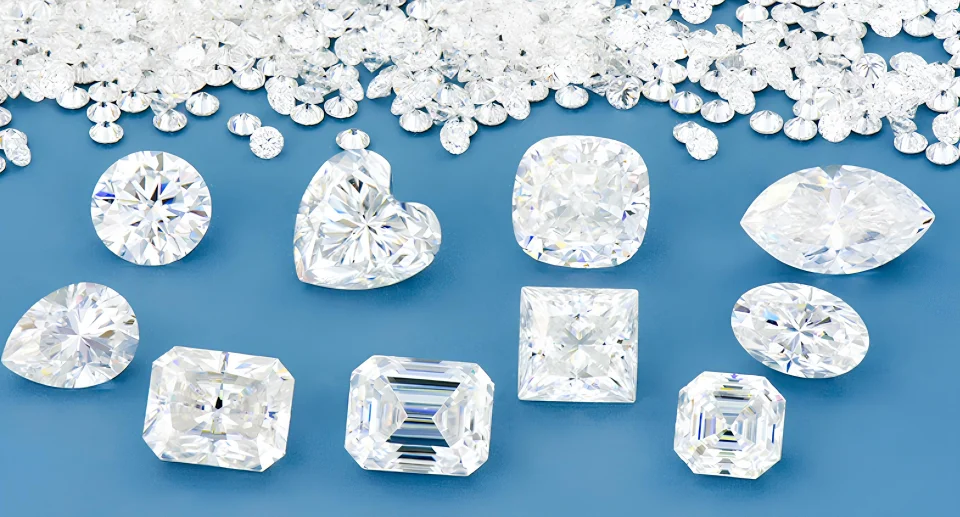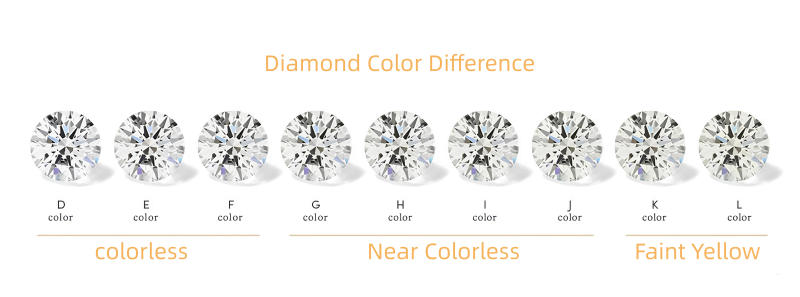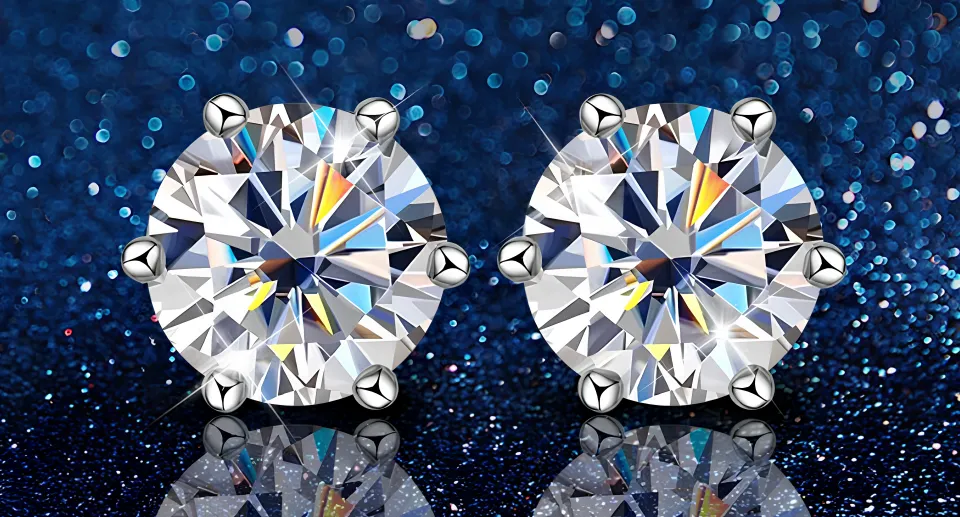
- by Mireli
- 15.05.2025
- Gifts, Museum, New collection
With its brilliant sparkle and timeless elegance, moissanite is often mistaken for a diamond—unless you’re a gemologist, telling them apart can be nearly impossible. This stunning gemstone has quickly gained popularity in engagement rings and fine jewelry, thanks to its exceptional clarity, impressive durability, and eye-catching brilliance. While moissanite delivers the same captivating fire and shine as a diamond, it comes at just a fraction of the cost. For couples seeking a luxurious look without the high price tag, moissanite offers an affordable and ethical alternative to traditional diamond rings.
Why Moissanite Engagement Rings Are More Popular Than Ever
Moissanite engagement rings are becoming the go-to choice for modern couples—and it’s easy to see why. With their dazzling brilliance, impressive durability, and budget-friendly price, moissanite rings offer all the sparkle of a traditional diamond without the steep cost. Whether you’re planning a proposal or searching for the perfect wedding jewelry set, moissanite delivers unmatched value and visual impact.
In fact, moissanite often outshines diamonds when it comes to fire and brilliance. Its ability to reflect light in a stunning rainbow effect gives it a lively, almost electric sparkle. Beyond beauty, moissanite is also highly durable—ranking 9.25 on the Mohs hardness scale—making it ideal for everyday wear and a lasting symbol of your commitment.
Another reason for moissanite’s growing popularity is its ethical and eco-conscious appeal. Unlike mined diamonds, most moissanite today is lab-created, meaning it has a much smaller environmental footprint. For couples who care about sustainability, this gemstone makes a thoughtful and responsible choice.
Moissanite isn’t just for engagement rings either. Its affordable price point makes it a beautiful option for wedding bands, anniversary gifts, and meaningful bridal party jewelry. From classic solitaire settings to elegant three-stone designs, moissanite allows you to celebrate love with brilliance—without compromising your budget or values.
The Origin and Pricing of Moissanite: What You Need to Know
Moissanite boasts a fascinating history rooted in cosmic origins. This extraordinary gemstone was first identified in 1893 by French scientist Henri Moissan while examining a meteorite crater in Arizona. Initially, he mistook the tiny crystals he found for diamonds. However, after closer analysis, he discovered that these sparkling particles were actually silicon carbide—a rare natural mineral now known as moissanite.
Natural moissanite remains incredibly scarce in the Earth’s crust, making it almost impossible to source in quantities suitable for jewelry. That’s why nearly all moissanite available today is lab-created, offering an ethical and affordable alternative to mined gemstones without compromising on beauty or durability.
What Determines the Cost of Moissanite Jewelry?
The price of moissanite jewelry varies based on several key factors. Much like diamonds, moissanite is evaluated through a grading system that influences its market value. Understanding these factors can help you make a confident purchase.
Moissanite Color Grading Explained
When it comes to color, moissanite can range from completely colorless to faintly tinted stones exhibiting subtle yellow or green hues. The industry typically grades moissanite color using a scale similar to that of diamonds:
Grades D, E, and F: Truly colorless, offering the highest brilliance and clarity
Grades G, H, and I: Near colorless, with only slight warmth visible under close inspection
Grades J and K: Slightly tinted, showing more noticeable hues
As with diamonds, the closer a moissanite is to colorless, the higher its value and price. Stones in the D-F range command a premium due to their exceptional clarity and sparkle.
By understanding these grading criteria, shoppers can better assess the quality of moissanite rings and other jewelry, ensuring they find the perfect balance of beauty and value.

Moissanite vs. Natural Diamond Price Comparison
When comparing prices, we look at popular settings such as solitaire 14kt white gold bands, featuring the highly sought-after round brilliant cut. For natural diamonds, color grades typically range from I to G, while clarity often falls between VS2 and VS1 — standards that balance quality and affordability. Moissanite offers exceptional brilliance and fire at a fraction of the cost, making it a preferred choice for budget-conscious buyers who want the sparkle of a diamond without the high price tag. Whether you’re shopping for an engagement ring or fine jewelry, moissanite presents a cost-effective alternative without compromising on appearance or durability.
| Carat Weight | Moissanite Avg. Price (USD) | Natural Diamond Avg. Price (USD) |
| 0.5 ct | $100 – $150 | $700 – $1,000 |
| 0.75 ct | $150 – $200 | $1,200 – $1,600 |
| 1.0 ct | $200 – $300 | $2,000 – $3,000 |
| 1.5 ct | $300 – $450 | $3,500 – $4,500 |
| 2.0 ct | $400 – $600 | $5,000 – $6,500 |
| 2.5 ct | $600 – $800 | $6,500 – $8,500 |
| 3.0 ct | $800 – $1,000 | $8,000 – $10,000 |
Notes:
Moissanite prices reflect loose stones in standard round brilliant cuts, D–F color, VVS clarity.
Diamond prices reflect GIA-certified stones with near-colorless grades (G–H) and VS clarity.
Cut Quality Assessment
The cut grade of moissanite depends primarily on its polish and symmetry, both of which directly influence how brilliantly the gem reflects light. Each moissanite shape has specific ideal cut proportions that must be achieved to maximize sparkle. Cut grades range from Fair and Poor to Good, Very Good, and Excellent, with stones that exhibit superior brilliance earning higher ratings.
Carat Weight and Size
Carat weight represents the actual mass of the gemstone, but the perceived size also depends heavily on the cut style. A well-cut moissanite with a “Very Good” rating typically has less depth and greater spread, making it appear larger than its measured carat weight. Generally, heavier carat stones command higher prices due to their rarity and visual impact.
Clarity Evaluation
Clarity refers to the presence of internal inclusions and external blemishes. Fewer inclusions mean a clearer gem, which enhances light performance and sparkle. While these imperfections are often microscopic and don’t usually detract from the gem’s beauty, they are crucial in professional grading. The clarity scale ranges from flawless to included, with most commercial moissanites graded as AAA or better to guarantee excellent visual quality.
Gemstone Quality Rankings
Grading tiers commonly used for moissanite and similar gems include AAAA, AAA, AA, A, and B. While AAAA grade gems are exceptionally rare and nearly flawless, AAA quality stones also offer stunning clarity and color comparable to top-tier specimens. Our selection focuses on AAA-grade moissanite to ensure you receive brilliant, eye-catching gemstones that combine beauty with value.
Moissanite Engagement Ring Pricing Explained: Comparing Costs by Carat and Quality
When considering a moissanite engagement ring, a common question is: how much does a moissanite diamond cost compared to a natural diamond? Understanding pricing by carat weight and quality can help you make a well-informed decision.
Moissanite vs. Natural Diamond Pricing Factors
Prices vary depending on factors like setting style, cut, color, and clarity. Popular choices include solitaire 14kt white gold bands with round-cut stones. Diamonds are typically graded from I to G in color and VS2 to VS1 in clarity. Moissanite offers comparable brilliance and durability at a significantly lower price, making it an appealing alternative for engagement rings and special gifts.
Cost of a 1-Carat Moissanite Ring
A nearly colorless, well-cut 1-carat moissanite ring usually costs around $600. In contrast, a 1-carat diamond with similar color and clarity can cost between $4,500 and $6,000. This price gap highlights moissanite’s value as a budget-friendly yet beautiful gemstone.
Cost of Larger Moissanite Stones: 2-Carat and 3-Carat Examples
As carat weight increases, so does the price. A 2-carat moissanite ring typically costs about $1,200, while a 3-carat ring ranges from $2,800 to $3,200. Natural diamonds of these sizes are substantially more expensive, sometimes costing tens of thousands of dollars.

Lab Diamonds vs. Moissanite: Which Is Right for You?
As more couples seek ethical and affordable alternatives to mined diamonds, two options often come into focus: lab-grown diamonds and moissanite. While both are popular choices for engagement rings and fine jewelry, they differ in composition, sparkle, color, and cost — making each suitable for different preferences and budgets.
Composition and Origin
Moissanite is a naturally occurring mineral called silicon carbide, originally discovered in a meteor crater. However, natural moissanite is extremely rare and found in very small crystals, which is why almost all moissanite on the market today is lab-created. Lab-grown diamonds, by contrast, are chemically identical to natural diamonds — composed of pure carbon and grown in high-tech laboratories under controlled conditions.
Sparkle and Light Performance
The most noticeable difference between moissanite and lab diamonds is how they reflect light. Moissanite is doubly refractive, giving off a high level of brilliance with a fiery, rainbow-like sparkle. This bold flash of color can appear more dramatic than a diamond’s subtler shine. On the other hand, lab-grown diamonds are singly refractive, offering a more classic, white-light sparkle that closely mimics a natural diamond.
Hardness and Durability
In terms of durability, both stones are excellent options. Diamonds — including lab-created ones — rate a perfect 10 on the Mohs scale of hardness, making them the hardest material on earth. Moissanite comes in close at 9.25 to 9.5, making it extremely tough and suitable for daily wear, including in engagement rings.
Color Range and Customization
Lab-grown diamonds can be found in a range of color grades — from colorless (D-F) to faint tints (G-J), and even fancy colors like blue, pink, or yellow. Moissanite is usually available in colorless, near-colorless, or faint yellow-green hues. There are also enhanced versions of moissanite available in blue or green tones, which are created using special coatings to expand color options for jewelry lovers.
Cost and Affordability
Moissanite typically costs significantly less than both natural and lab-grown diamonds. For example, a 1-carat moissanite may cost between $300–$600, while a lab diamond of the same size and quality might range from $1,000–$3,000, depending on its grading. This makes moissanite a fantastic option for those who want maximum sparkle on a budget, while lab-created diamonds appeal to those who desire the traditional diamond look at a more accessible price than mined stones.
Certification and Symbolism
One major distinction is certification. Lab-grown diamonds can be IGI or GIA certified, which is important for resale value and authenticity. Moissanite is not graded the same way as diamonds but can still be evaluated by reputable sellers for clarity, color, and cut.
Final Thoughts
If you’re drawn to a brilliant, colorful sparkle and want an affordable yet durable gemstone, moissanite is a stunning choice for engagement rings or everyday jewelry. But if you value the authenticity and structure of a traditional diamond with a certified report, a lab-grown diamond offers the best of both worlds — beauty and ethical sourcing.
No matter which gemstone you choose, both moissanite and lab diamonds represent thoughtful, modern alternatives to mined diamonds — perfect for celebrating love in a meaningful and responsible way.